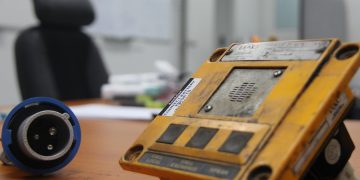Fascination About Roar Solutions
Fascination About Roar Solutions
Blog Article
The Single Strategy To Use For Roar Solutions
Table of ContentsRoar Solutions Things To Know Before You Get ThisNot known Details About Roar Solutions Roar Solutions Fundamentals Explained
In such an atmosphere a fire or explosion is feasible when 3 fundamental conditions are met. This is frequently referred to as the "unsafe location" or "combustion" triangle. In order to protect installments from a possible surge a method of evaluating and classifying a possibly hazardous area is required. The function of this is to make certain the correct option and installation of tools to inevitably stop a surge and to make certain safety of life.
(https://my.omsystem.com/members/roarsolutions)
No tools should be installed where the surface temperature of the equipment is more than the ignition temperature of the given hazard. Below are some common dirt hazardous and their minimal ignition temperature. Coal Dust 380C 225C Polythene 420C (melts) Methyl Cellulose 420C 320C Starch 460C 435C Flour 490C 340C Sugar 490C 460C Grain Dust 510C 300C Phenolic Resin 530C > 450C Aluminium 590C > 450C PVC 700C > 450C Residue 810C 570C The chance of the threat existing in a focus high sufficient to trigger an ignition will vary from area to area.
Hazardous area electric tools possibly created for use in higher ambient temperatures. Area Repair Work By Authorised Worker: Difficult testing may not be called for however certain procedures may require to be adhered to in order for the devices to preserve its 3rd event score. Each piece of tools with a harmful rating should be evaluated individually.
The 10-Second Trick For Roar Solutions
The equipment register is a comprehensive database of tools records that consists of a minimum set of areas to identify each product's area, technical criteria, Ex category, age, and ecological data. This details is crucial for monitoring and managing the devices properly within dangerous locations. On the other hand, for regular or RBI tasting evaluations, the quality will certainly be a combination of In-depth and Close inspections. The ratio of In-depth to Shut evaluations will be established by the Equipment Danger, which is analyzed based on ignition risk (the likelihood of a resource of ignition versus the probability of a flammable environment )and the harmful location category
( Zone 0, 1, or 2). This variation will likewise affect the resourcing demands for work preparation. Once Whole lots are specified, you can develop sampling plans based on the sample size of each Lot, which refers to the number of random devices products to be checked. To figure out the called for example dimension, 2 facets require to be reviewed: the dimension of the Whole lot and the group of inspection, which indicates the level of effort that should be applied( reduced, normal, or raised )to the inspection of the Lot. By combining the category of inspection with the Lot dimension, you can after that develop the proper being rejected requirements for a sample, implying the allowable variety of damaged things located within that example. For more details on this process, please refer to the Power Institute Guidelines. The IEC 60079 common suggests that the maximum interval in between assessments ought to not exceed 3 years. EEHA assessments will also be conducted outside of RBI campaigns as component of arranged upkeep and devices overhauls or repair work. These inspections can be attributed toward the RBI example sizes within the affected Whole lots. EEHA evaluations are conducted to recognize faults in electric tools. A weighted racking up system is necessary, as a single item of equipment might have multiple mistakes, each with varying degrees of ignition risk. If the consolidated score of both assessments is less than two times the mistake score, the Whole lot is considered acceptable. If the Whole lot is still taken into consideration unacceptable, it should undergo a full examination or validation, which may activate more stringent examination procedures. Accepted Whole lot: The reasons of any kind of faults are recognized. If a common failing setting is found, extra tools may need inspection and repair service. Mistakes are classified by seriousness( Safety and security, Integrity, House cleaning ), making certain that urgent problems are examined and addressed quickly to alleviate any kind of impact on security or operations. The EEHA data source need to track and record the lifecycle of faults along with the restorative activities taken. Implementing a robust Risk-Based Evaluation( RBI )technique is vital for ensuring conformity Visit Website and safety in handling Electric Devices in Hazardous Areas( EEHA) (eeha). Automated Mistake Rating and Lifecycle Monitoring: Easily manage faults and track their lifecycle to improve inspection accuracy. The intro of this support for risk-based evaluation additionally reinforces Inspectivity's placement as a best-in-class option for regulative compliance, as well as for any asset-centric evaluation usage instance. If you want discovering much more, we invite you to ask for a demonstration and uncover exactly how our service can change your EEHA administration processes.
The smart Trick of Roar Solutions That Nobody is Discussing

In regards to explosive threat, a hazardous area is a setting in which an explosive ambience is present (or may be expected to be existing) in quantities that call for unique safety measures for the building and construction, installation and use tools. hazardous area electrical course. In this article we check out the challenges faced in the office, the threat control steps, and the required competencies to function safely
These substances can, in specific conditions, create explosive ambiences and these can have significant and terrible effects. Many of us are familiar with the fire triangular remove any type of one of the three elements and the fire can not occur, but what does this mean in the context of unsafe areas?
In most circumstances, we can do little concerning the levels of oxygen airborne, yet we can have considerable influence on resources of ignition, for example electrical tools. Unsafe locations are recorded on the unsafe area category illustration and are recognized on-site by the triangular "EX LOVER" sign. Below, amongst various other essential details, zones are split into three types depending on the danger, the possibility and duration that an eruptive atmosphere will certainly exist; Area 0 or 20 is regarded one of the most hazardous and Area 2 or 22 is regarded the least.
Report this page